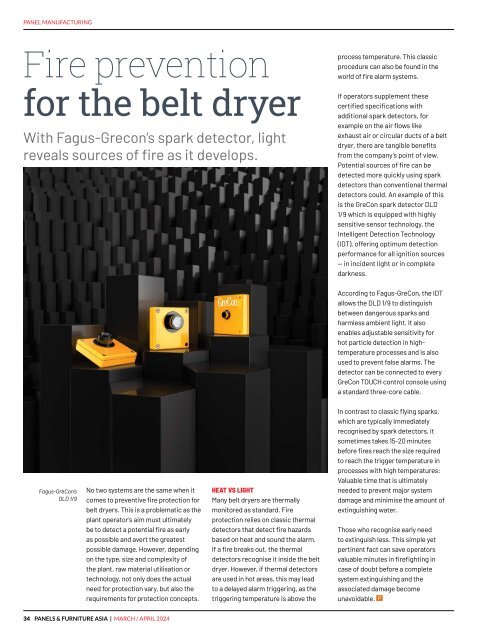Panels & Furniture Asia March/April 2024
Panels & Furniture Asia (PFA) is a leading regional trade magazine dedicated to the woodbased panel, furniture and flooring processing industry. Published bi-monthly since 2000, PFA delivers authentic journalism to cover the latest news, technology, machinery, projects, products and trade events throughout the sector. With a hardcopy and digital readership comprising manufacturers, designers and specifiers, among others, PFA is the platform of choice for connecting brands across the global woodworking landscape.
Panels & Furniture Asia (PFA) is a leading regional trade magazine dedicated to the woodbased panel, furniture and flooring processing industry. Published bi-monthly since 2000, PFA delivers authentic journalism to cover the latest news, technology, machinery, projects, products and trade events throughout the sector. With a hardcopy and digital readership comprising manufacturers, designers and specifiers, among others, PFA is the platform of choice for connecting brands across the global woodworking landscape.
Create successful ePaper yourself
Turn your PDF publications into a flip-book with our unique Google optimized e-Paper software.
PANEL MANUFACTURING<br />
Fire prevention<br />
for the belt dryer<br />
With Fagus-Grecon’s spark detector, light<br />
reveals sources of fire as it develops.<br />
process temperature. This classic<br />
procedure can also be found in the<br />
world of fire alarm systems.<br />
If operators supplement these<br />
certified specifications with<br />
additional spark detectors, for<br />
example on the air flows like<br />
exhaust air or circular ducts of a belt<br />
dryer, there are tangible benefits<br />
from the company’s point of view.<br />
Potential sources of fire can be<br />
detected more quickly using spark<br />
detectors than conventional thermal<br />
detectors could. An example of this<br />
is the GreCon spark detector DLD<br />
1/9 which is equipped with highly<br />
sensitive sensor technology, the<br />
Intelligent Detection Technology<br />
(IDT), offering optimum detection<br />
performance for all ignition sources<br />
— in incident light or in complete<br />
darkness.<br />
According to Fagus-GreCon, the IDT<br />
allows the DLD 1/9 to distinguish<br />
between dangerous sparks and<br />
harmless ambient light. It also<br />
enables adjustable sensitivity for<br />
hot particle detection in hightemperature<br />
processes and is also<br />
used to prevent false alarms. The<br />
detector can be connected to every<br />
GreCon TOUCH control console using<br />
a standard three-core cable.<br />
Fagus-GreCon’s<br />
DLD 1/9<br />
No two systems are the same when it<br />
comes to preventive fire protection for<br />
belt dryers. This is a problematic as the<br />
plant operator’s aim must ultimately<br />
be to detect a potential fire as early<br />
as possible and avert the greatest<br />
possible damage. However, depending<br />
on the type, size and complexity of<br />
the plant, raw material utilisation or<br />
technology, not only does the actual<br />
need for protection vary, but also the<br />
requirements for protection concepts.<br />
HEAT VS LIGHT<br />
Many belt dryers are thermally<br />
monitored as standard. Fire<br />
protection relies on classic thermal<br />
detectors that detect fire hazards<br />
based on heat and sound the alarm.<br />
If a fire breaks out, the thermal<br />
detectors recognise it inside the belt<br />
dryer. However, if thermal detectors<br />
are used in hot areas, this may lead<br />
to a delayed alarm triggering, as the<br />
triggering temperature is above the<br />
In contrast to classic flying sparks,<br />
which are typically immediately<br />
recognised by spark detectors, it<br />
sometimes takes 15-20 minutes<br />
before fires reach the size required<br />
to reach the trigger temperature in<br />
processes with high temperatures:<br />
Valuable time that is ultimately<br />
needed to prevent major system<br />
damage and minimise the amount of<br />
extinguishing water.<br />
Those who recognise early need<br />
to extinguish less. This simple yet<br />
pertinent fact can save operators<br />
valuable minutes in firefighting in<br />
case of doubt before a complete<br />
system extinguishing and the<br />
associated damage become<br />
unavoidable. P<br />
34 PANELS & FURNITURE ASIA | MARCH / APRIL <strong>2024</strong>

















